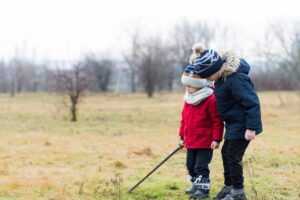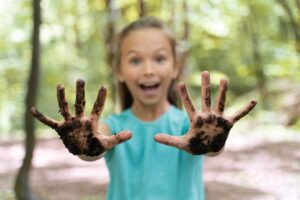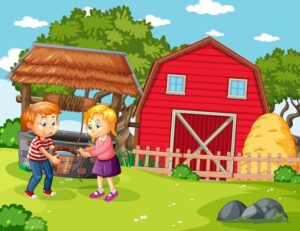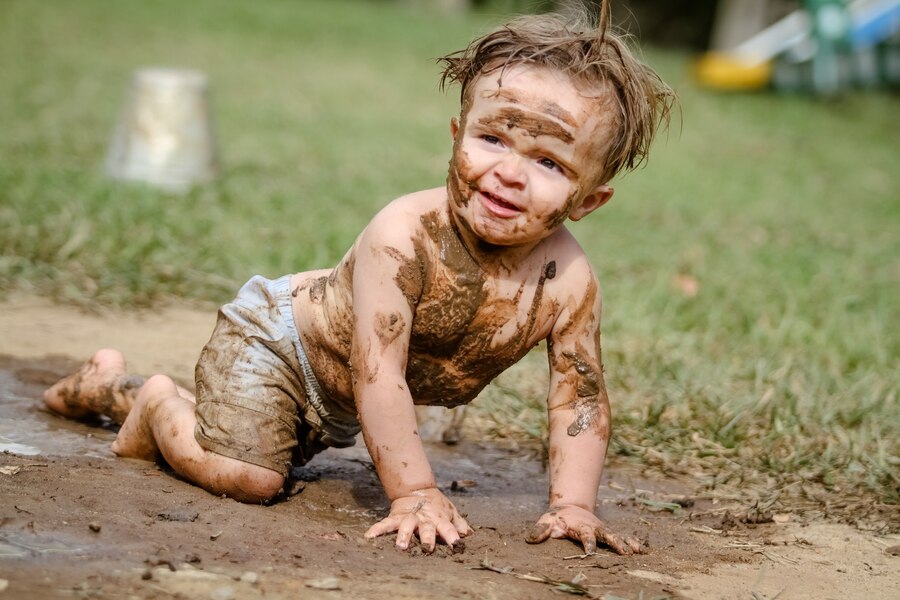Once upon a time, ‘not getting dirty’ was a common household phrase, especially when parents watched their children soiling their best clothes with dismay. Whether they were running across fields, climbing trees, or catching frogs, the children’s white clothes had to turn brown (in mud or mud water)before the end of the day.
Today, many parents secretly wish that their children would pick up a handful of dirt and play with it. In the age of urban lifestyle, thanks to social media and video games, children are now less in touch with nature. Many children never get a chance to play in the dirt or mud water.
This may reduce your laundry expenses but results in poor health and well-being of the baby. According to a recent study, soil contains friendly bacteria that can train children’s immune systems to protect them from a variety of allergies, asthma, and other illnesses, including depression and anxiety.
These results suggest that such physical activity is beneficial not only because it allows for free movement, but also because some natural materials, such as soil and mud, contain surprisingly powerful microorganisms that can. We have only just begun to understand the positive health effects of these germs.

Mental development:
The many psychological benefits of playing outdoors are now a concrete reality. Our minds evolved in natural places and our sensory system is most attuned to the natural landscape.
This means that natural scenery provides our mind with just the right level of stimulation that helps re-energize a tired and easily distracted mind.
A 2009 study provided evidence in favor of this theory. The study found that children with attention-deficit hyperactivity disorder (ADHD) were able to focus better on their tasks after a 20-minute walk in a park than on clean city streets. This ability was less in children who walked for 20 minutes.
Proximity to grass and trees apparently had a positive effect on their minds. Experts suggest that ‘nature’s dose’ is a safe and readily available tool, along with other methods, to improve children with ADHD.

In addition to mental stimulation, outdoor play can also be a great learning tool. For example, Francesco Vetrano, a child psychologist at the University of Palermo in Italy, says that by kneading clay and making different things with it, children can develop the connection between their feelings and their movements. As sensorimotor development is called, children gradually begin to understand the signals generated in their bodies.
Connecting with Nature for Emotional Growth: Outdoor Activities for Children
Activities outside of homes and classrooms can also provide opportunities for children to understand their feelings in ways that other environments may not. For example, in sand tray therapy, you express your feelings and thoughts with the help of clay and small sculptures made from it. This approach is now considered effective counseling for children who are having difficulty putting words to their emotional state.
When it comes to children’s physical health, the best benefit of playing outside may be exercised. According to Elizabeth Gershoff, a professor of human development and family sciences at the University of Texas at Austin in the United States, and her team’s research, it is easier for children who play in a wide open space to gain physical strength, which makes them obese. The risk is reduced.
But the latest findings suggest that playing in the natural environment may have many more benefits, and the secret may be in the soil, alive and kicking.
Old friends:

The new research sheds new light on the ‘hygiene hypothesis’, which was first proposed in the late 80s.
According to this theory, the drastic decline in childhood infections in the 20th century has negatively affected people’s immune systems, causing them to overreact to even the slightest external stimulus. As a result, it is believed to be the cause of asthma, pollen allergies, and food allergies.
Many scientists now dislike the term ‘hygiene hypothesis’ because it seems to discourage important behaviors such as hand washing.
And they also dislike the notion that infections are somehow beneficial to children.
Christopher Lowery, professor of physiology at the University of Colorado in the United States, says, “From a public health point of view, there were many problems.”
Instead, it is now thought that the key role is played by microbes that do not spread the infection. These ‘old friends’ have been with us for much of our evolutionary history. They are generally harmless and train our immune system to moderate its activity and not overreact against a potential invader.
The Importance of Exposure to Nature for Children’s Immune Systems
Importantly, our bodies meet these old friends when we spend time in nature. Due to increased urban lifestyles and decreased outdoor play, many children are no longer exposed to these good germs, so their immune systems become oversensitive and potentially overactive.
Importantly, our bodies meet these old friends when we spend time in nature. Due to increased urban lifestyles and decreased outdoor play, many children are no longer exposed to these good germs, so their immune systems become oversensitive and potentially overactive.
Several research studies support this idea. People who grow up on farms and ranches are less likely to develop asthma, allergies, or immune system diseases such as Crohn’s disease, apparently because they are exposed to more germs in rural environments. Helps the immune system to function effectively and moderately.
The healthiest stimulus these bacteria provide probably comes from the digestive system. It is now well known to scientists that the friendly bacteria in the digestive system can improve our health in many ways, but according to Dr. Michele Antonelli, who researches mud therapy in Reggio Emilia, Italy, they are also present on our skin. Can be and can benefit us through it as well.
He says that many species of bacteria live on the outer layer of our body, and people with atopic dermatitis and psoriasis, a common form of eczema, appear to have a lower number and diversity of bacteria on their skin.
Bacterial diversity also appears to be associated with joint inflammation or arthritis. “These microscopic germs play an important role in many serious diseases.”
Healthy body, healthy mind:

Surprisingly, nature-friendly insects help moderate the body’s response to stress.
When we feel vulnerable and threatened, the immune system begins to increase inflammation in the body. Since inflammation is one of the first defenses against infection, this response evolved to prepare the body for potential physical injury from the threat we were facing. But it is less useful for the kind of stress that most people face today.
Notably, people who spent their childhood days in rural environments feel less pressure when speaking in stressful situations like those who grew up in cities. This held true even when the scientists controlled for other factors such as their socioeconomic status.
This can have profound long-term health implications, as chronic inflammation can manifest in many forms. For example, it can increase the risk of depression.
According to Lori, who co-authored a research paper, individuals who have grown up in urban areas have a higher risk of inflammation, similar to a ticking time bomb.
Dramatic Effects:

As findings supporting the ‘old friends hypothesis’ began to emerge, some researchers began to identify the specific organisms that may be responsible for these benefits and the mechanisms by which these changes occur. Lowry is particularly interested in Mycobacterium villi, which can often be found in soil. When mice are exposed to make, they show the enhanced activity of regulatory T cells. As the name suggests, it helps control immune activity including inflammatory responses.
They then appear to be more resilient to stressful events such as a potential confrontation with another, more aggressive mouse. “We see very dramatic effects on stress flexibility even a month after the last injection,” says Lowry.
Of course, mice are not like human babies, but it offers some clues about the role that some microorganisms can play.
From Mud Kitchens to Roundworms
Some scientists have also expressed much enthusiasm about the role of ‘helminths’. Soil-dwelling insects such as roundworms are activated in the body by a largely moderate immune response. People who have been infected with helminths have a reduced risk of inflammatory bowel diseases.
Given the importance of the early benefits of friendly bacteria, many scientists are investigating the benefits of interventions that encourage greater contact with nature in childhood.
Of course, mice are not like human babies, but it offers some clues about the role that some microorganisms can play in mud.
Some scientists have also expressed much enthusiasm about the role of ‘helminths’. Soil-dwelling insects such as roundworms are activated in the body by a largely moderate immune response. People who have been infected with helminths have a reduced risk of inflammatory bowel diseases.
Because of the significance of the positive effects of beneficial microorganisms in the early stages of life, many researchers are studying the potential benefits of increased exposure to nature during childhood.
Many daycare centers and schools are already encouraging greater contact with nature, seeing its psychological benefits. Regular walks in open spaces and the construction of mud kitchens encourage children to play in the dirt.
“There is a growing awareness in many nurseries and schools that children have less open spaces to play,” says Marlisa Modena, an architect who specializes in designing school buildings. “We’re looking at ways to reintroduce activities that, up until about 50 years ago, were part of children’s everyday experiences.”
Modena says that more interest in outdoor sports started in Northern Europe, but is now spreading to many other countries.
The most surprising thing is that naturally occurring microbes also moderate our body’s response to stress.
The Science Behind Mud Play: How it Benefits Children’s Development
Playing in mud provides several benefits to children, including:
- Sensory development: Touching and playing with mud helps children develop their sense of touch and proprioception, which is the awareness of their body in space.
- Physical development: Mud play can help children develop fine motor skills, balance, and coordination.
- Imagination and creativity: Playing in the mud is an open-ended activity that allows children to use their imaginations and be creative.
- Problem-solving skills: Mud play can challenge children to figure out how to build structures, make shapes, and clean up afterward, which helps develop their problem-solving skills.
- Social and emotional development: Playing in the mud can provide children with opportunities to collaborate, negotiate, and develop social skills.
- Connection to nature: Playing in mud helps children feel connected to nature and understand their place in the environment.
Read Next:
A Doctor Selfless Battle to Save a Child’s Life
Top Foods for Optimal Child Development 0-5 Years Age
Foods to avoid when pregnant
Smartphone: At what age should a child be given?
Contact: Make Appointment
Comment below !
Sharing is Caring

